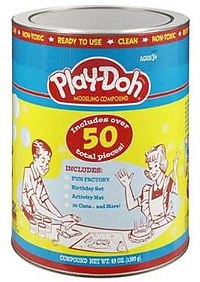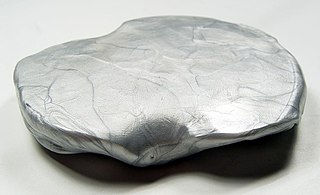
Silly Putty is a toy containing silicone polymers that have unusual physical properties. It can flow like a liquid, bounce, stretch, or break depending on the amount of physical stress to which it is subjected. It contains viscoelastic liquid silicones, a type of non-Newtonian fluid, which makes it act as a viscous liquid over a long time period but as an elastic solid over a short time period. It was originally created during research into potential rubber substitutes for use by the United States in World War II.

Hasbro, Inc. is an American multinational conglomerate holding company incorporated and headquartered in Pawtucket, Rhode Island. Hasbro owns the trademarks and products of Kenner, Milton Bradley, Parker Brothers, and Wizards of the Coast, among others. As of August 2020, over 81.5% of its shares were held by large financial institutions.

Plasticine is a putty-like modelling material made from calcium salts, petroleum jelly and aliphatic acids. Though originally a brand name for the British version of the product, it is now applied generically in English as a product category to other formulations.
Kenner Products, known simply as Kenner, was an American toy company founded in 1946. Throughout its history, the Kenner brand produced several highly recognizable toys and merchandise lines including action figures like the original series of Star Wars, Jurassic Park and Batman as well as die cast models. The company was closed and merged by its corporate parent Hasbro in 2000.

Polymer clay is a type of hardenable modeling clay based on the polymer polyvinyl chloride (PVC). It typically contains no clay minerals, but like mineral clay a liquid is added to dry particles until it achieves gel-like working properties. Similarly, the part is put into an oven to harden, hence its colloquial designation as clay. Polymer clay is generally used for making arts and craft items, and is also used in commercial applications to make decorative parts. Art made from polymer clay can now be found in major museums.

The Easy-Bake Oven is a working toy oven introduced in 1963 by Kenner and currently manufactured by Hasbro. The original toy used a pair of ordinary incandescent light bulbs as a heat source; current versions use a true heating element. Kenner sold 500,000 Easy-Bake Ovens in the first year of production. By 1997, more than 16 million Easy-Bake Ovens had been sold.

Nerf is a toy brand formed by Parker Brothers and currently owned by Hasbro. Most of the toys are a variety of foam-based weaponry, with other Nerf products including balls for sports such as American football, basketball, and baseball. Their best known toys are their dart guns that shoot ammunition made from "Nerf foam". Their primary slogan, introduced in the 1990s, is "It's Nerf or Nothin'!". Annual revenues under the Nerf brand are approximately US$400 million.
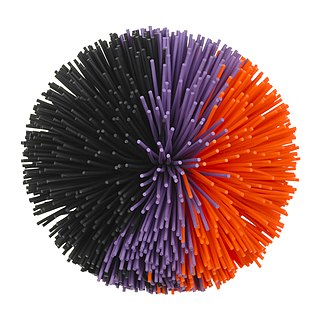
The Koosh ball is a toy ball made of rubber filaments (strands) radiating from a steel-bound core, patented in 1987 by Scott H. Stillinger. The company later expanded their product line to include 50 other Koosh-related products, including keyrings, baseball sets, and yo-yos.

Playskool is an American brand of educational toys and games for children. The former Playskool manufacturing company was a subsidiary of the Milton Bradley Company and was headquartered in Chicago, Illinois. Playskool's last remaining plant in the aforementioned city was shut down in 1984, and Playskool became a brand of Hasbro, which had acquired Milton Bradley that same year.

Tomy Company, Ltd. is a Japanese toy company. It was established in 1924 by Eiichirō Tomiyama as Tomiyama Toy Manufacturing Company (富山玩具製作所), became known for creating popular toys like the B-29 friction toy and luck-based game Pop-up Pirate. In 2006, Tomy merged with another toy manufacturer, Takara, and although the English company name remained the same, it became Takara Tomy in Asia. It has its headquarters in Katsushika, Tokyo.

I Love Toys is a miniseries on VH1 and the eighth installment of the I Love the... series that premiered on March 6, 2006. It is a countdown of the 100 greatest toys, chosen partially through public voting on vh1.com and also consideration of "sales, historical significance and longevity," according to VH1.

Colorforms is a creative toy named for the simple shapes and forms cut from colored vinyl sheeting that cling to a smooth backing surface without adhesives. These pieces are used to create picture graphics and designs, which can then be changed countless times by repositioning the removable color forms. The name also refers to the specific registered trademark brand these products are produced under, as well as the company that manufactures the toys, Colorforms Brand, LLC.
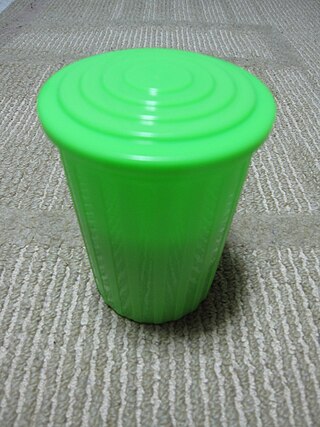
Slime is a toy product manufactured by Mattel, sold in a plastic trash can and introduced in February 1976. It consists of a non-toxic viscous, squishy and oozy green or other color material made primarily from guar gum. Different variations of Slime have been released over the years, including Slime containing rubber insects, eyeballs, and worms.

Palitoy was a British toy company. It manufactured some of the most popular toys in Britain, some original items and others under licence. Its products included Action Man, Action Girl, Action Force, Tiny Tears, Pippa, Tressy, Mainline Model Railways, Merlin, Star Wars figures, Play-Doh and the Care Bears.
Rainbow Crafts, Inc. is a former toy manufacturing company created and operated by Noah McVicker and his nephew Joseph McVicker as a subsidiary of the midwestern soap company, Kutol Products. The company manufactured Play-Doh, a modeling compound for children. Rainbow Crafts operated under the McVickers from 1956 until 1965 when it was sold to General Mills with all rights to Play-Doh. In 1971, Rainbow Crafts and Kenner merged.
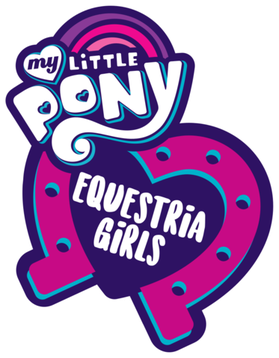
My Little Pony: Equestria Girls, simply known as Equestria Girls or EQG, is a product line of fashion dolls and a media franchise launched in 2013 by the American toy company Hasbro as a spin-off of the 2010 relaunch of the My Little Pony line of pony toys and its Friendship Is Magic television series. Equestria Girls features anthropomorphized versions of My Little Pony characters from that period; as with My Little Pony, which features a colorful body and mane, Equestria Girls characters sport non-human skin and hair colors, while incorporating their pony counterpart's cutie marks in their clothing. The franchise includes various doll lines, media tie-ins, and licensed merchandise.
Kutol Products Company, Inc. is a privately held manufacturer of commercial skin care products founded in 1912 and headquartered in Cincinnati, Ohio. Kutol specializes in hand soaps, hand sanitizers, hair and body washes, heavy duty and industrial hand cleaners, specialty skin care products and dispensing systems. Kutol products are distributed throughout the world but mainly in the United States and Canada.
Doh-Vinci is a Hasbro arts and craft toy which combines Play-Doh with 3D printing. The kits include a soft form of Play-Doh, a 3D styling tool and a base such as a vanity set for the children to decorate. The Play-Doh comes in tubes which fit into the styling tool and are then extruded from a nozzle to make shapes in a similar manner to frosting cakes. It is similar to the 3Doodler except uses Play-Doh instead of plastic.
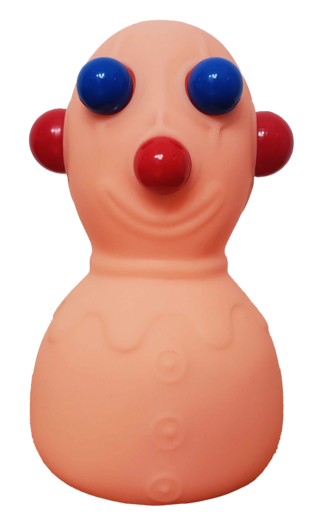
Panic Pete, also known as Jo-Bo, Obie, The Martian Popping Doll, The Martian Popping Thing, Popping Martian or Bug-Out Bob is a novelty rubber squeeze toy invented by John M. Auzin.

